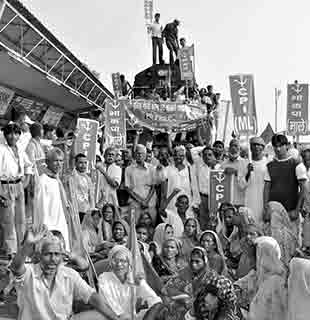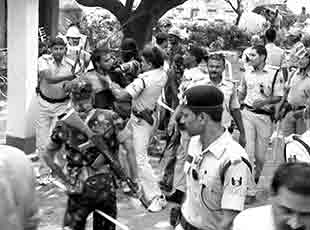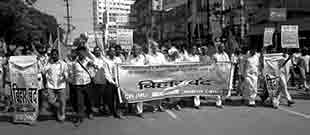 iring in Madhubani district leading to the killing of two students – Nishant Jha and Ravindra Yadav – with several other students lying in hospital with grievous bullet injury, having been fired at by the police at above-the-waist levels.
iring in Madhubani district leading to the killing of two students – Nishant Jha and Ravindra Yadav – with several other students lying in hospital with grievous bullet injury, having been fired at by the police at above-the-waist levels. Madhubani was of course no isolated incident. On October 11, thousands of people, including a large number of girl students, were brutally beaten up by the police at Paraiya in Gaya. The protesters were demanding police action against the lumpen goons who
 had gang-raped a girl student, yet instead of arresting the rapists, the police rained lathis and tear gas shells on the protesters. One of the protesters, Durgi Majhi, who was hit on the head with a rifle butt is now lying in PMCH in a critical state. Another scene of police brutality was enacted at Ara where dalit students observing an indefinite fast were whisked away by the police in a pre-dawn swoop on 14 October and beaten up brutally inside the police station. Incidentally, Nitish Kumar was scheduled to visit Ara on 14 October in course of his Adhikar Yatra.
had gang-raped a girl student, yet instead of arresting the rapists, the police rained lathis and tear gas shells on the protesters. One of the protesters, Durgi Majhi, who was hit on the head with a rifle butt is now lying in PMCH in a critical state. Another scene of police brutality was enacted at Ara where dalit students observing an indefinite fast were whisked away by the police in a pre-dawn swoop on 14 October and beaten up brutally inside the police station. Incidentally, Nitish Kumar was scheduled to visit Ara on 14 October in course of his Adhikar Yatra. The Madhubani incidents had a long build-up. Prashant Jha, and Preeti Chaudhary, both Class X students, had eloped since 7 September as the girl’s family was fiercely opposed to their relationship. The girl’s family is well-heeled and well-connected, and they promptly managed to have some of the boy’s relatives put in jail and threatened to have the boy bumped off. When the matter was brought to Nitish Kumar’s attention at the time of his Adhikar Yatra visit to the district, he did nothing to get the issue resolved. Against this backdrop when a beheaded body was discovered on October 3, Prashant’s mother thought it was her son’s body and demanded it be handed over to the family. The police refused and the mother accompanied by several women soon sat in an indefinite dharna.
On October 12, students joined in and called Madhubani bandh, but the police retaliated by attacking the women in the dharna. Veteran CPI leader and ex MLA Ram Naresh Pandey, and Prof CM Jha, President of the District unit of Jan Sanskriti Manch, who were there to express solidarity with women were also badly beaten up by the police. This triggered public outrage across the district and the trigger-happy police and para-military forces went berserk, killing at least two and injuring scores of people. Forced on the backfoot, for the first time Nitish Kumar admitted an ‘administrative lapse’, transferred the DM and SP of Madhubani, the IG of Darbhanga Range and the girl’s father who is the District Education Officer, and announced a judicial probe.
Surprisingly, on 15 October afternoon
 Prashant and Preeti were spotted near Mehrauli in Delhi, and as the information reached the Delhi Police and the Bihar DGP, the two were asked to surrender. Sections of the media have since started painting the bandh as a false move that only reflected utter desperation on the part of the opposition in Bihar to destabilise the Nitish Kumar government. Nitish Kumar, who has been arrogantly dismissing the protests of the people during his Adhikar Yatra as acts of political conspiracy hatched by the opposition, sees this as a new opportunity to deride the people and their protests.
Prashant and Preeti were spotted near Mehrauli in Delhi, and as the information reached the Delhi Police and the Bihar DGP, the two were asked to surrender. Sections of the media have since started painting the bandh as a false move that only reflected utter desperation on the part of the opposition in Bihar to destabilise the Nitish Kumar government. Nitish Kumar, who has been arrogantly dismissing the protests of the people during his Adhikar Yatra as acts of political conspiracy hatched by the opposition, sees this as a new opportunity to deride the people and their protests. 
To dub the October 15 Bihar Bandh a false move simple because the teenage couple surrendered in Delhi and the boy who was presumed dead by his own mother was found alive, would be a travesty of truth and an utter misreading of the situation in Bihar. Even if the bandh is seen only in the very limited and specific context of Prashant and Preeti, the fact remains that the future of the teenage lovers remains as uncertain and insecure as ever. Given the backdrop of the honour killings going on across the country, most prominently in states adjoining Delhi, and the shocking case of the Rizwanur murder in Kolkata, it is important to guard against lapsing into any kind of complacence, and instead remain ever alert to ensure that Prashant and Preeti are allowed to determine and shape their own future without any external pressure or fear. The Bihar government or Bihar police had absolutely no role in spotting them in Delhi, and cannot therefore claim any credit whatsoever for the dramatic discovery of the two teenagers the same afternoon when people were protesting in Bihar. If anything, the two teenagers may have been influenced by the developments in Madhubani and elsewhere in Bihar in deciding to surrender.

More importantly, the October 15 Bihar Bandh was by no means limited to the issue of Prashant and Preeti, it was above all against the increasingly autocratic character and conduct of the Nitish Kumar government. If bureaucratic highhandedness and all-pervasive corruption were the hallmarks of Nitish Kumar’s first term in power, growing police repression and unmitigated arrogance of the Chief Minister himself have emerged as the defining features of the ongoing second term. The protests witnessed in his recent meetings and the growing popular participation in struggles for justice and change carry two clear messages for whoever cares to read them: (i) Bihar is not enamoured of Nitish Kumar’s ‘special category status’ campaign for the state, it sees this as nothing but a political ploy by a ruler who has belied the hopes and denied the rights of the people in every sphere; (ii) just as India in 1977 had rebuffed the Congress claim of “Indira is India, and India is Indira”, Bihar too is in no mood to accept Nitish Kumar’s megalomaniac illusion “Nitish Kumar is Bihar, Bihar is Nitish Kumar”.

Nitish Kumar had begun with the rhetoric of development and in recent years his government was making astounding claims of recording the highest and fastest development rate in India. Why then this sudden turnaround and the new-found realisation that Bihar can develop only by attaining the special category status? One look at the existing special category states would tell anybody that special status is no recipe for development or democracy – almost all the special category states in the North-East are notorious for the loot of funds meant for various development schemes, brutal customary suppression of human rights and the resultant maze of ethnic violence. Nitish Kumar would like to use the special category status demand to divert public attention from every failure and betrayal of his government and to justify any pre- or post-poll alliance-hopping in the coming days.
Nitish Kumar’s new-found politics of special category state – he never supported this demand when the CPI(ML) raised it at the time of Bihar’s bifurcation, or in the elections of 2005 or 2010 – amounts to nothing short of a confession of failure of his much-publicised politics and economics of development. His bluff of using the issue of special category status for Bihar as a supra-party agenda representing the whole of Bihar has already been exposed quite mercilessly in the course of his Adhikar Yatra. Faced with mass protests and various sections of the people demanding their own ‘adhikar’ (rights), he now calls it a JD(U) affair restricted only to JD(U) activists! The Chief Minister of Bihar, certified as ‘prime ministerial material’ by his deputy, has actually shown himself to be nothing more than an arrogant and unscrupulous JD(U) leader who talks about ‘Bihari asmita’ (pride in Bihar) only as long as he does not have to face any inconvenient question. He has perhaps become so fond of seeing his own smiling portrait in the ubiquitous newspaper ads and hoardings that he forgets to smile in real life and asks his party men of the Ranvir Yadav variety to teach the people a befitting lesson!
Nitish Kumar would do well to remember that Indira Gandhi’s Emergency-era legal censorship had not worked; the team of her sycophants and loyalists could not save her from the wrath of the people in the epochal 1977 election. Can Nitish Kumar’s advertisement-inspired control over the media in Bihar fare any better?

After October 15 Bihar Bandh, the countdown has now begun for the next showdown in November. On November 4, Nitish Kumar will have his ‘Adhikar Rally’ at Patna’s Gandhi Maidan, a show for which the entire state government had been preparing rather obsessively for the last three or four months. The reply from the fighting people of Bihar will come on November 9 when the CPI(ML) will hold the Parivartan Rally at the same historic site. While Nitish Kumar seeks to invoke Bihari pride by getting more grants from the Centre (as of now the state government cannot account for Rs 25,000 crore of funds it has withdrawn from the treasury, what the scale will be after Bihar gets special category status is anybody’s guess), the CPI(ML) represents the fighting legacy of Bihar wedded to the dream of ‘a New Bihar in a New India’, combining the battle against oppression and injustice within Bihar with the larger national task of defending democracy and transforming the conditions of the people and the complexion of the country.
Incidentally, after a long period of silence and passivity, Lalu Prasad has also hit the street with the slogan of Parivartan. But his talk of ‘Parivartan’ is only a dream to ‘restore’ his rule in Bihar. Even as the whole country fights against corruption, corporate loot, invasion of FDI and assault on democracy, Lalu Prasad stands most loyally by the discredited Congress party and UPA government. When the people of Bihar talk of ‘parivartan’ (change), they fight for an alternative. In the 1970s Bihar showed the way to end the stranglehold of Emergency. In 1989 in the wake of Bofors scam and Bhagalpur riots, Bihar played a leading role in the quest for a national political alternative. It was this search which saw the rise of the Janata Dal as a major entity, and it was the same quest that also saw the IPF/CPI(ML) emerge as a powerful force in the Left movement.
Two decades later, the Janata Dal today stands divided in multiple factions. The two streams in Bihar have abandoned their non-Congress, non-BJP plank, the RJD has become an appendage to the Congress, while the JD(U) has become one of the most trusted partners of the BJP. But the country once again looks for a national political alternative; it seeks not only a change of guard at the Centre but a change of policy direction for the country. Bihar cannot be kept away from this national quest; on the contrary the people of Bihar can only be a big source of strength and energy for this national battle. The CPI(ML) remains committed to provide the people of Bihar with a most credible and consistent medium to intensify the battle against corruption and for parivartan (transformation), nationally as well as in Bihar. The contrast between the two rallies of 4 and 9 November – the rally of the arrogance of repressive power versus the rally of the determination of the fighting people – will be an important pointer to know which way the wind is blowing.